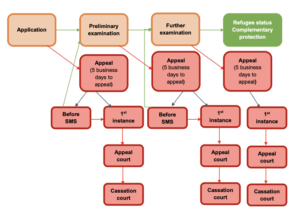
Introduction to the asylum context
For many years, Ukraine has served as both a transit and destination country for individuals escaping persecution and violence from other parts of the world.[1] In 2021, around 5,000 asylum applicants and refugees[2] were either seeking refuge in Ukraine or passing through on their way to the EU.[3] Of these, 2,382 were granted refugee status or complementary protection in Ukraine, while 2,719 were asylum seekers. Women and girls made up 54 per cent of the refugees and asylum seekers in Ukraine. The prevailing country of origin was Afghanistan.[4]
While refugees had several different routes to enter Ukraine, the primary pathways prior to 2022 included regular air travel and irregular crossings through the borders with Russia and Belarus.[5] Additionally, there have been reports of refugee movements via Odesa in southern Ukraine, with individuals traveling from Türkiye across the Black Sea.[6]
On February 24, 2022, Russia’s full-scale invasion of Ukraine triggered a humanitarian crisis, displacing millions of people, including asylum seekers and refugees who were already in the country. Many of them had to flee yet again. As of April 2025, 4,6 million people were internally displaced[7] , and 6,9 million protection seekers from Ukraine were recorded globally.[8]
In the first half of 2022, due to open frontiers with the EU and simplified border controls, 1,283 registered asylum applicants who were in contact with the UNHCR fled Ukraine seeking safety from the escalating conflict. However, the actual number may be higher as precise figures are unavailable. Additionally, an unknown number of irregular migrants also left the country during this period.[9] Migrant communities in Ukraine, including asylum seekers, refugees, and persons in need of complementary protection, lost an average of 70% of their members in 2022.[10]
In addition, over 43,610 civilian casualties have been verified as of March 2025, and this number is likely to be considerably higher.[11] Since the beginning of 2023, Russian attacks have continued to damage homes and energy facilities.[12] As of April 23, 2025, Russia has temporarily occupied a total of 112,632 km², amounting to 18.66% of Ukraine’s territory.[13]
In 2022 and 2023, only a few migrant groups experienced growth, notably those of citizens from the Russian Federation and Belarus.[14] In the context of war, the number of asylum seeker arrivals has decreased, but instead, the number of asylum seekers sur place has grown notably due to Russians and Belarusians who either condemned the Russian aggression and/or joined the Ukrainian Armed Forces.[15] Thus, the landscape of asylum seekers’ and refugees’ countries of origin has shifted, with Russia leading the list, followed by Syria, Tajikistan, Belarus, and Afghanistan as of August 2023.[16]
In addition, some Belarusians and Russians have been subjected to legislative changes[17] that now pose an obstacle to extending residence permits that they have had for years. An asylum application is seen as the only opportunity to regularise their status in Ukraine. However, the SMS often rejects their applications (see Statistics), leaving them in legal limbo.
[1] UNHCR, Multi-Year, Multi-Partner Protection and Solutions Strategy for Ukraine, 2018 – 2022, January 2018, available here.
[2] UNHCR, the UN Refugee Agency, available here.
[3] IOM, Irregular Migrants in Ukraine Analytical Summary, 13 April 2021, available here.
[4] R2P, The Study: Community organisations: resources for protecting refugees and asylum seekers in Ukraine, 20 December 2023, available here.
[5] R2P observations.
[6] ICMPD, Q&A: How closed borders detour migrant routes, 15 March 2016, available here.
[7] IOC, Internally displaced persons, 07 April 2025, available here.
[8] UNHCR, Ukraine Refugee Situation, 17 April 2025, available here.
[9] R2P & HIAS, Asylum Seekers and Refugees in Ukraine Addressing Protection Risks During Wartime, 05 April 2023, available here.
[10] R2P, The Study: Community organisations: resources for protecting refugees and asylum seekers in Ukraine, 20 December 2023, available here.
[11] Statista, Number of civilian casualties in Ukraine during Russia’s invasion verified by OHCHR from February 24, 2022 to March 31, 2025, available here.
[12] OCHA, Ukraine Humanitarian Response 2023: Situation Report, 23 November 2023, available here.
[13] Deepstatemap, 23 April 2025, available here.
[14] R2P, The Study: Community organisations: resources for protecting refugees and asylum seekers in Ukraine, 20 December 2023, available here.
[15] R2P observations.
[16] The list is based on UNHCR data of asylum seekers and refugees benefiting from legal assistance from UNHCR. R2P, The Study: Community organisations: resources for protecting refugees and asylum seekers in Ukraine, 20 December 2023, available here.
[17] Procedure for simplified issuance and exchange of temporary residence permits for citizens of the Republic of Belarus who are entrepreneurs, highly qualified specialists, in particular specialists in the field of information technology and innovation, whose urgent need is tangible for the economy of Ukraine, and who have applied in the prescribed manner to the territorial bodies/divisions of the State Migration Service for an immigration permit, and their family members dated 23 December 2020 No. 1303; ZMINA, The Migration Service Should Allow Citizens of Belarus, Including Volunteers of the Armed Forces of Ukraine, to Legalise in Ukraine, 09 August 2022, available in Ukrainian here.

